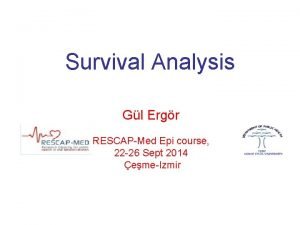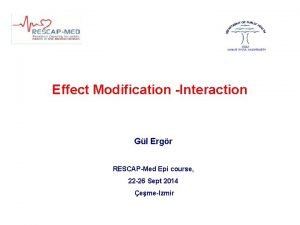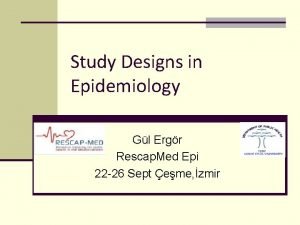Study Designs in Epidemiology Gl Ergr Rescap Med



















- Slides: 19

Study Designs in Epidemiology Gül Ergör Rescap. Med Epi 22 -26 Sept Çeşme, İzmir

Aims of medical research n Defining a disease or health condition n Assesing the prevalance or incidence of a disease n Biological mechanism of a disease n Etiology or risk factors n Prognosis n Comparing therapies n Assesing the validity of a diagnostic or screening test

Study Designs OBSERVATIONAL n Descriptive Case report/series Analytic Ecologic studies Cross sectional Case control Cohort EXPERIMENTAL • Clinical Trial • Field Trial


Study Design Sequence Hypothesis formation Case series Case reports Descriptive epidemiology Analytic epidemiology Clinical trials Hypothesis testing Cohort Casecontrol Crosssectional

Increasing Knowledge of Disease/Exposure Descriptive Studies Develop hypothesis Case-control Studies Investigate it’s relationship to outcomes Cohort Studies Define it’s meaning with exposures Clinical trials Test link experimentally

Descriptive studies n Assemble morbidity or mortality statistics, usually n n n from routine sources Data on health - related variables (e. g. surveillance, health services utilisation) Report the information according to meaningful categories, such as: Time (when it occurs) Place (whereit is found) Person (who is affected)

Analytic studies n The analysis of descriptive data often leads to hypothesis formation based on observed correlations between diseases or health related states and possible determinants. n The hypotheses generated need to be tested by planned field studies designed to examine if: n people with disease have common attributes, or have been exposed to the same agent; n people with particular attributes who are exposed to a specific agent are more likely to develop disease than those who do not have those attributes.

Ecological Study

Cross sectional study (Survey) üQuestionnaire üLab tests üPhysical exam Study population Sample Prevalance Size Selection

CASE-CONTROL STUDY Start of the study Exposed Cases Unexposed Exposed Unexposed Controls

COHORT STUDY Start of the study Diseased Exposed Healthy Cohort Diseased Unexposed Healthy Direction of the study

Retrospective Cohort study Exposed Outcome Non-exposed Outcome Measure exposure and confounder variables Baseline time Study begins here

Randomized Clinical Trial - RCT Outcome New therapy Eligible patients No outcome Randomisation Outcome Standard therapy Direction of the study No outcome

Randomized Field Trial Disease Preventive intervention Population No disease Randomisation Disease No intervention Direction of the study No disease

Systemmatic Review Meta-Analysis Study A Study B Study C Meta-analysis Study D

Summary of epidmiologic studies


 Ergr
Ergr Ergr
Ergr Ergr
Ergr What is descriptive study in epidemiology
What is descriptive study in epidemiology Asli med nedir
Asli med nedir Vce english language study design
Vce english language study design Classification of study designs
Classification of study designs Ukuran asosiasi adalah
Ukuran asosiasi adalah Define nutritional epidemiology
Define nutritional epidemiology Logistic regression epidemiology
Logistic regression epidemiology Prevalence rate formula
Prevalence rate formula Ecological study design
Ecological study design Attack rate calculation
Attack rate calculation Difference between descriptive and analytical epidemiology
Difference between descriptive and analytical epidemiology Person place time epidemiology
Person place time epidemiology Difference between descriptive and analytical epidemiology
Difference between descriptive and analytical epidemiology Incidence and prevalence meaning
Incidence and prevalence meaning Pros and cons of cross sectional study
Pros and cons of cross sectional study Causal vs association
Causal vs association Attack rate epidemiology formula
Attack rate epidemiology formula



































